Definitive Gatorade Ranking

Key Findings
-
Overall, the most popular Gatorade flavors tested are all blue-ish: Icy Charge, Cool Blue, and Arctic Blitz topped the charts of public opinion.
-
However, preferences toward Gatorade flavors are heavily driven by age. The preference for the blue-ish options is heavily driven by our younger respondents. Respondents over the age of 40 prefer Fruit Punch and Orange – some of the more classic flavors – to the bluish portion of the Gatorade spectrum.
-
Familiarity is positively correlated with preference. The Gatorade flavors that are more well known are more likely to be favorably rated on average.
-
Color is the overwhelming choice in how to refer to specific Gatorade types rather than flavor. While Conservatives/Libertarians refer to Gatorade by flavor name, once again age is the main predictor of attitudes. Younger respondents (18-29) are more likely to refer to the color than older respondents.
About The Survey
Like many people living in quarantine during the current pandemic, I’ve found myself engaging in deep, heartfelt conversations with those who are forced to live with me. One such argument conversation started after one of my roommates noticed a Gatorade in the room and thought: “Yes, this is the thing that we will talk about now.” Now, I consider myself a Gatorade connoisseur and thought that I had a pretty refined taste. However, as we started listing out different types of Gatorade and started ranking them – like we did with fruit – I quickly learned that some of my roommates think that Orange Gatorade is trash, while the other half (the enlightened half) think that Orange Gatorade is good. This news was a revelation: how could someone not agree with me on Gatorade?
To help answer this question, I turned to the only tool at my disposal: a survey of a non-random sample of people that is nowhere near representative of the general public. So, to the Gatorade marketing team reading this, take the findings with a grain of salt, but also maybe throw some Gatorade swag my way? For a full breakdown of the survey demographics, see the table in the Appendix
The survey is still open and collecting responses, but as of publishing this, 409 people have thrown their taste preferences into the crucible of public opinion. So, if you haven’t taken it yet, please go here: https://forms.gle/DYo7zotAp7BTZc1T6 and fill the survey out before reading on.
Side note: there are about a billion different variants of Gatorade out there on the market; Gatorade even offers a line of USDA-certified organic thirst quenchers (#greenwashing). Certain decisions had to made and lines in the sand had to be drawn over which flavors to include and exclude. While it was actually tough to nail down a list of all the flavors that Gatorade has carried, I presented 13 flavors that people would know and have strong opinions about, as well a few of the more left-field offerings. However, in this selection process, I made a glaring omission: Riptide Rush. I offer my sincerest, heartfelt apologies to all the Riptide Rush fans out there for this omission. Riptide Rush didn’t deserve this.
Definitive Gatorade Ranking
Overall, the three blue Gatorades top the charts of public opinion, with Icy Charge from the Frost series narrowly leading Cool Blue and Arctic Blitz. The two more classic offerings, Lemon Lime and Fruit Punch, come in at fourth and fifth place. Fierce Grape is quite the polarizing flavor; while it’s in the bottom three, one fifth of respondents rated it as A-tier (and another fifth rated it as F-tier). Lime Cucumber received the highest amount of negative sentiment, with 27% of respondents who reported knowing/trying the flavor rating it as F-tier. At the very bottom in the dumpster of public opinion, Fierce Green Apple sits as both the most unknown and most hated of flavors.
Funnily enough, attitudes towards Orange Gatorade nearly matches my household consensus; half of respondents ranked Orange as A/B-tier, while the other half ranked it in the C/D/F-tiers.
Note: The chart below shows the proportion of tier ratings with the “Don’t Know/Never Tried” counts removed from the denominator. So the percentages can be interpreted as the percent of people that rated each type among everyone that had an opinion. The “Don’t Know/Never Tried” percentages are shown next to the tier ratings. The chart is also rank sorted by Gatorade GPA
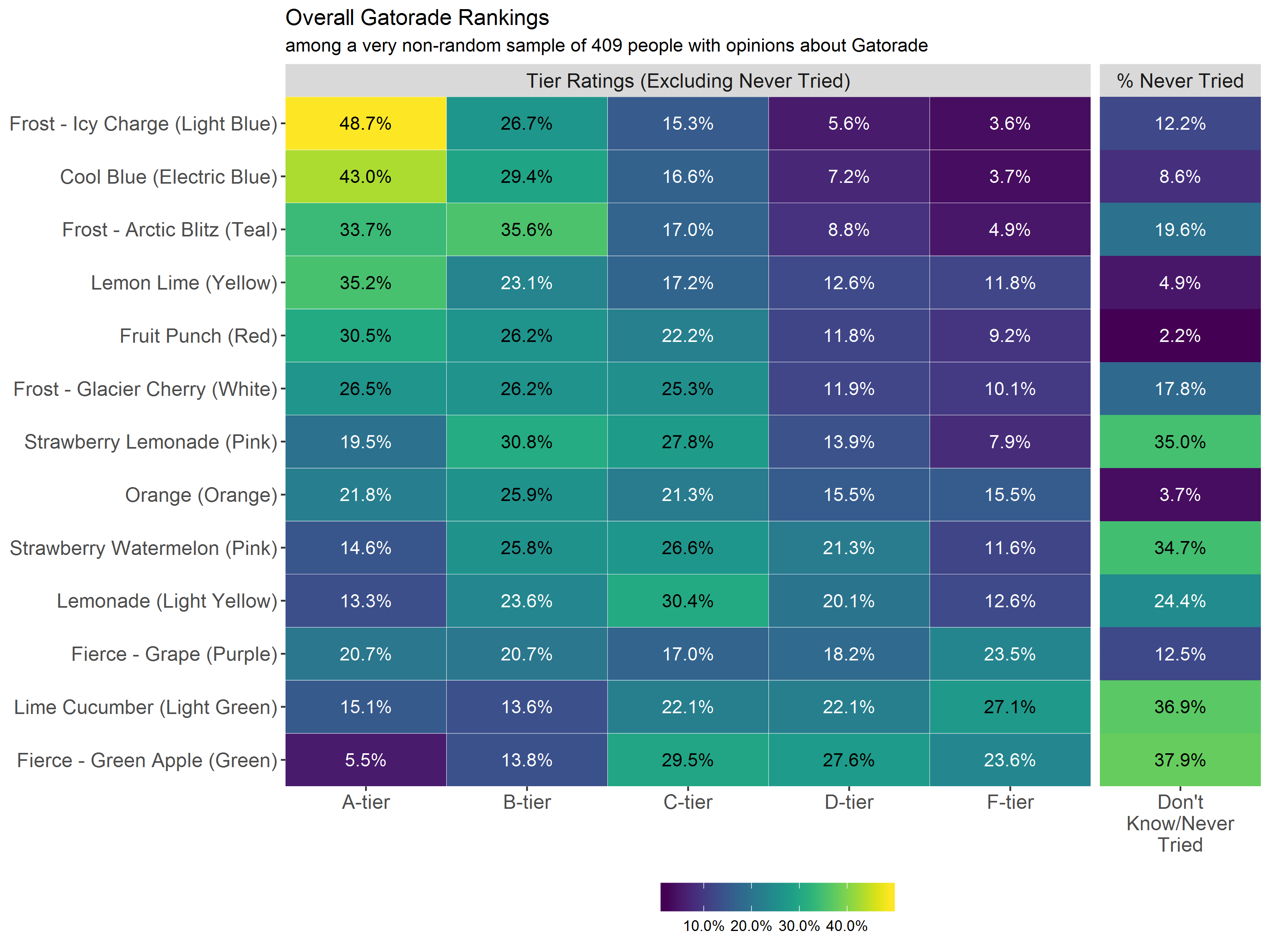
Similar to the Fruit Survey, I created a Gatorade GPA, which converts the grade tier ranking to a 0.0 to 4.0 GPA scale, which allows for a single data point that captures the distribution of rankings and removes any “Never tried” responses from the equation.
Even when we remove the “Never tried” responses, the more rare offerings, such as Green Apple, Lime Cucumber, and Strawberry Watermelon, still score the lowest. However, Strawberry Lemonade stands out as one of the underappreciated gems; a third of respondents had never tried it, but those who have tried it tended to rate it higher than average.
Interestingly, there is a relatively positive linear relationship between familiarity and favorability towards various flavors. On average, a one percent unit increase in familiarity leads to a .16 increase in Gatorade GPA with an R-squared of .37). This means that the more people are familiar with a flavor, the more likely they are to rate it favorably.
Additionally, both of my personal favorites – Fierce Grape and Orange – are outliers to this linear model, sitting in the Square of Death, with higher than average familiarity and lower than average ranking, meaning that most people know them and they hate them. If you need to reach me, I’m going to be in a dark room coping with the fact that I have poor taste in Gatorade.
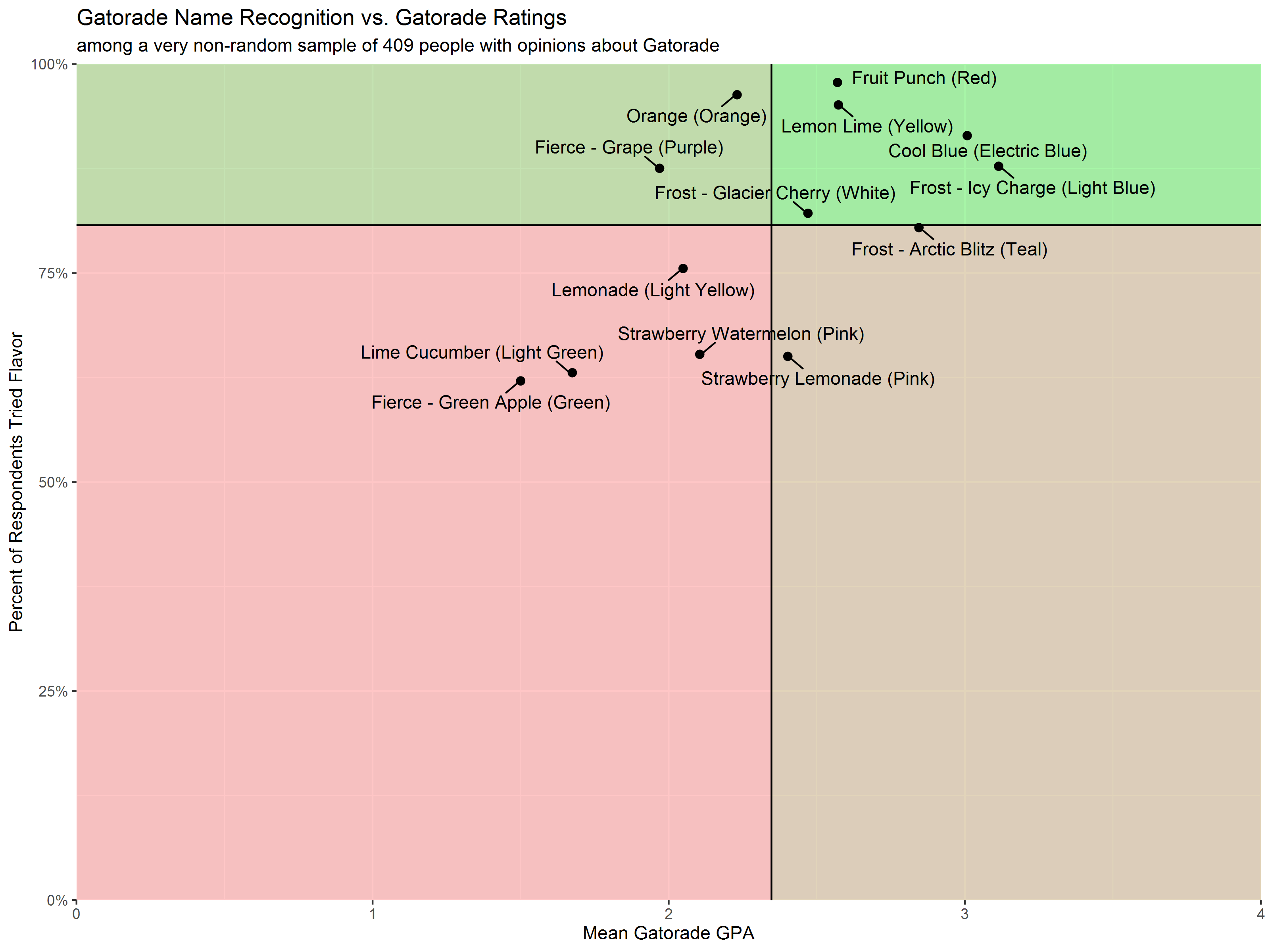
Note: Everything to the left of the vertical line above are rated lower than average and everything to the right is rated higher than average. Similarly, everything below the line is less well know/tried than average and everything above is more well known/tried.
Unsurprisingly, there are similarities in preferences between certain flavors. The strongest correlations in preferences can be found with the two Strawberry flavors tested – Strawberry Lemonade and Strawberry Watermelon. Additionally positive relationships can be found two of the three Frost flavors tested – Icy Charge and Arctic Blitz.
On the other hand, the strongest negative relationships can be found with Lime Cucumber and Fruit Punch – we’ll get into the driving forces behind this later on.

Gatorade Ranking by Demographics
As always, topline numbers are great, but what we really want to see is how the numbers change within and compare across various demographic groups to really find out what truly divides us.
Opinions by Gender
On average, men rated all of the colors slightly higher than women and non-binary respondents. Generally, attitudes across the gender spectrum tend to follow the same overall pattern, though with a varying degrees of intensity. However, there are some interesting gaps in opinion by gender. Men tend to be more favorable towards Grape than women and non-binary respondents, while women rated Strawberry Lemonade higher than their counterparts. Non-binary respondents show the strongest support for Lime Cucumber, though I think this may be driven by the respondent who identifies as “limon pepino” – thanks for that by the way.

While men may have a higher average Gatorade GPA, women have a much wider distribution of opinions – which can be found in the higher rating of Icy Charge and a much lower rating of Green Apple. Men tend to cluster closer to the mean score, while women show greater variety of opinions. This backs up previous research on fruit preference, which showed a similar distribution of opinions by gender.
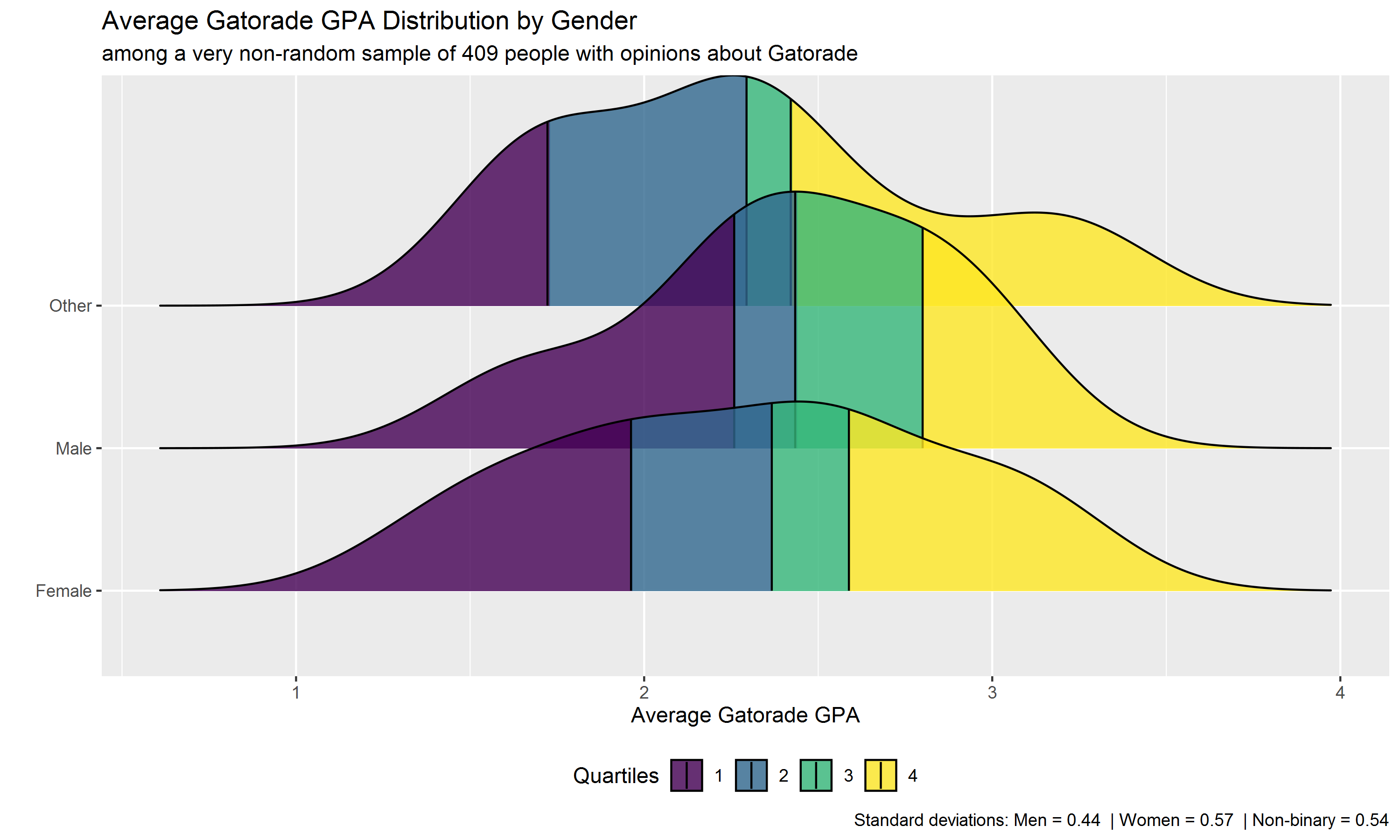
Opinions by Ideology
Politics are becoming more and more inescapable; creeping into conversations around sports and whether or not you listen to your doctor, but does ideological identity also impact Gatorade preference? No, not really, though that would be a cool headline if it did, wouldn’t it?
Our (very small) group of Conservative/Libertarian respondents are the most favorable towards Gatorade overall, showing the strongest support for the Lemon Lime – the most traditional of all Gatorade flavors. Leftists tend to be slightly more favorable towards Lime Cucumber than the Conservative/Libertarian bloc, though they are still largely unfavorable towards it.
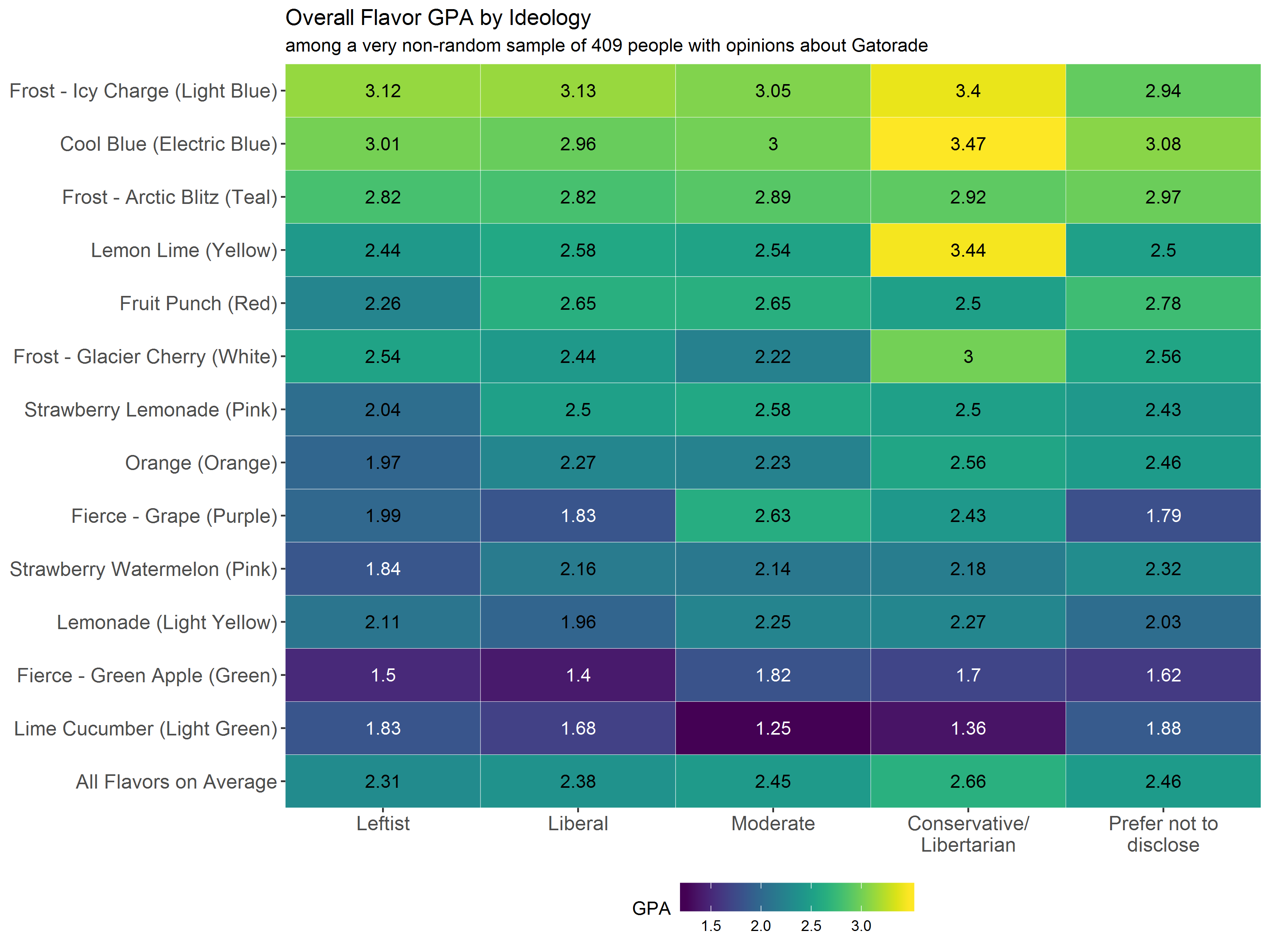
Opinions by Age
Of all of the demographics tested, age provided the greatest differences in our sample. Survey respondents over the age of 40 viewed the more “traditional” flavors, such as Fruit Punch and Orange most favorably and much more favorably than younger respondents, and showed strong distaste for Lime Cucumber (remember the negative correlation between Fruit Punch and Lime Cucumber from before?). On the other hand, the respondents in the youngest age bracket (18-29) are much more favorable to “the blues” – Icy Charge, Electric Blue and Arctic Blitz.
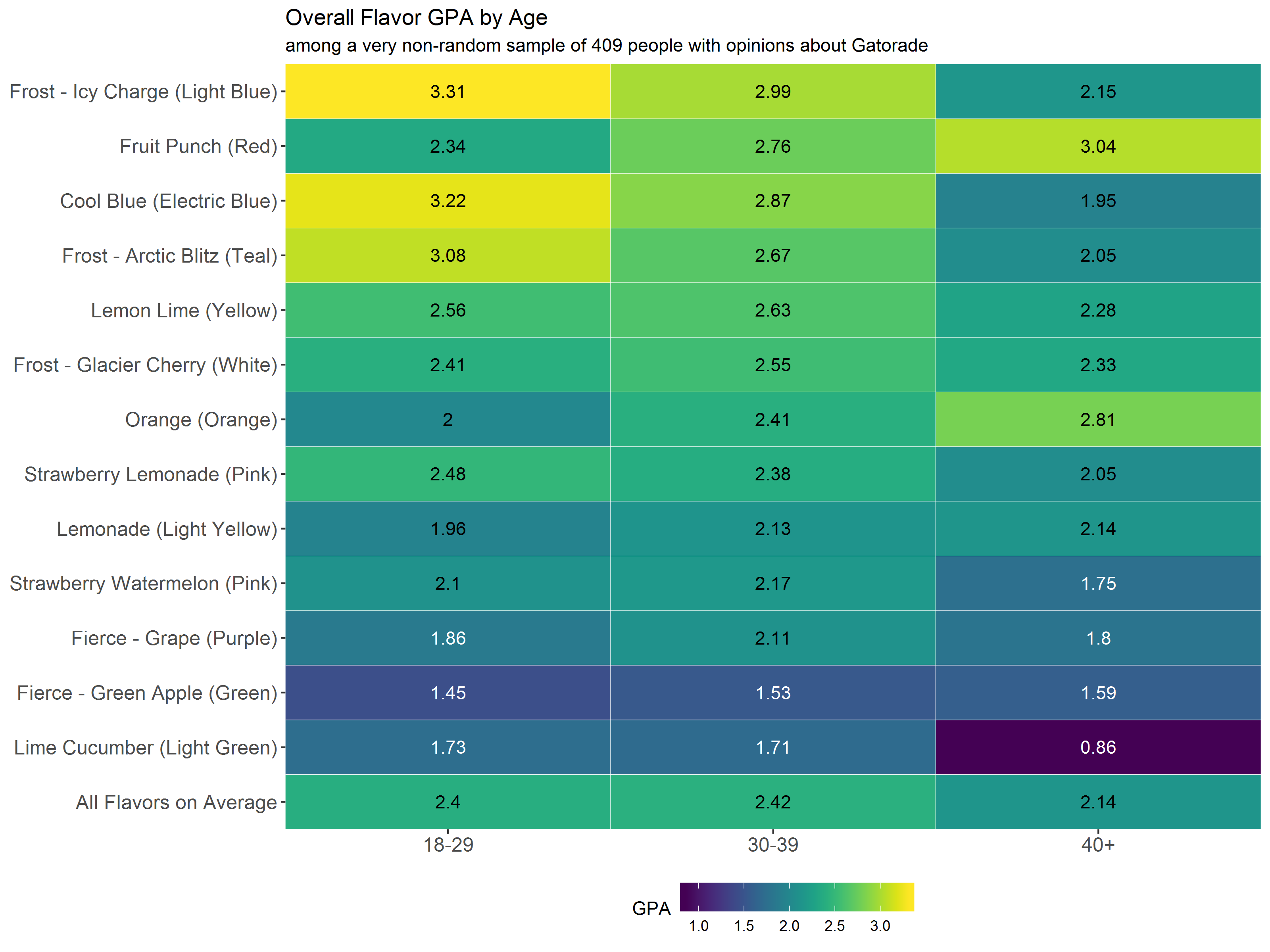
Further illustrating the significant role that age plays in attitudes towards Gatorade preference, I ran a series of logistic regression models to predict positive attitudes towards each flavor tested while controlling for multiple demographic variables. Across all of the flavors where we saw a generational divide, age was the only significant predictor of preference when controlling for race, gender, income and favorability towards Gatorade. Also of note, men were significantly more likely to be favorable towards Grape and Lemon Lime than women while controlling for other demos.
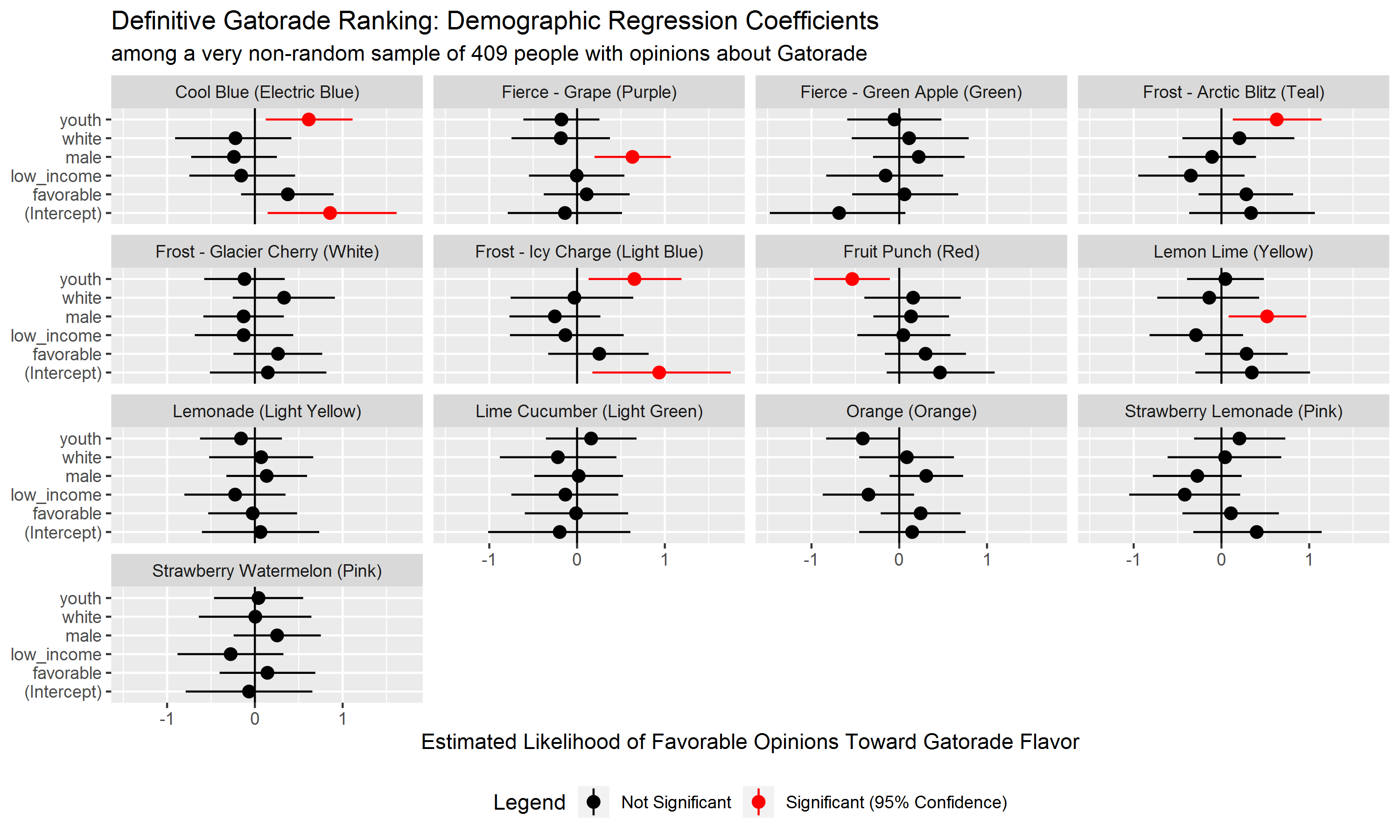
To bring this all together (and because I could), I ran a Principal Component Analysis to further illustrate the grouping of the various flavors and attitudes by demographics. This helps map out clusters of similarly rated flavors: we can see a grouping of our more popular flavors, including the Blues and Lemon-Lime. However, Fruit Punch, while being a popular choice is off in it’s own segment, which as we saw in the previous sections is being driven by our 40+ survey respondents who tend to view the Blue colors with distaste.
Lime Cucumber, unknown and unloved to most, is off in its own part of the graph plotting our collective demise.

Flavor or Color: How do you refer to Gatorade?
As you’ve probably noticed, I’ve been referring to each of the Gatorade types interchangeably as both flavors and colors. I do this mostly because there are four or five “blues” and a few yellows, which would make this analysis a little ambiguous and hard to follow. However, in general, if someone is going to the store asks if I want anything, I won’t say “get me some of that Riptide Rush.” Instead, I’ll just say “purple,” knowing full well that there are many options but I’ll generally be happy with anything in that part of the color spectrum.
However, there are some out there who don’t use this technique – despite the fact that it’s pretty well established that you can’t trust people who refer to Gatorade by the flavor – so I decided to include this as a demographic question.
Overall, our survey respondents overwhelmingly report that they refer to a specific Gatorade by the color, not the flavor – with 85% against 15%. This pattern (mostly) holds true across all demographics, with the majority reporting that they refer to the color. However, nearly a third of our (admittedly, very small N-size) Conservative/Libertarian respondents use the flavor as a descriptor.

Of course, as with all things in this survey, age is yet again the only significant predictor on this topic. When controlling for age, Gatorade favorability, gender, ideology, income, and race, younger respondents are more likely to refer to Gatorade by the color (and the inverse is true for older respondents).
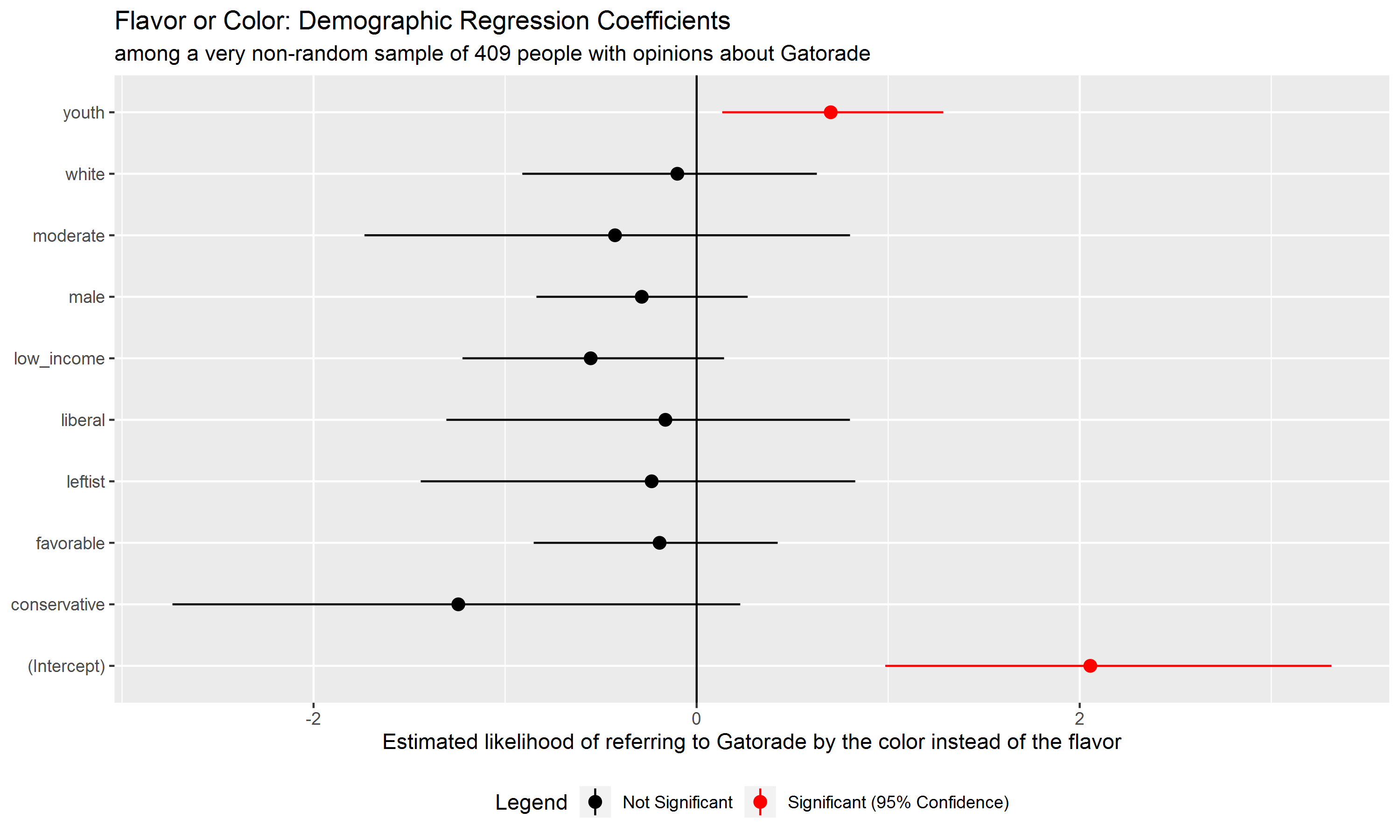
Thanks & Conclusion
Thank you to everyone who took the survey and eagerly shared it with their network – special thanks to my roommates Mahkah, Mika and Chris (even though some of them are wrong about Orange Gatorade) for pushing me to actually release the survey after I wrote it and then was too chicken to send it out and the Snacket for just being crazy fanatic about snacks. Obviously I wouldn’t be able to do any of this work without you all taking the time to enter your opinions.
All of the analysis project was done in R. Source code can be found here: https://github.com/GWarrenn/this-and-that/blob/master/definitive-gatorade-ranking/scripts/gatorade-ranking.R. If you have any interest in the underlying data, please reach out (I’d rather not just post the data publically without any kind of data suppression).
Survey Demographics
| Demographic Summary Table | |||
| Response | N | Percent | |
|---|---|---|---|
| Age | |||
| 18-29 | 206 | 50.0% | |
| 30-39 | 174 | 43.0% | |
| 40+ | 29 | 7.0% | |
| Income | |||
| Under $50,000 | 83 | 20.0% | |
| $50,000 to $100,000 | 148 | 36.0% | |
| Over $100,000 | 115 | 28.0% | |
| Prefer not to disclose | 63 | 15.0% | |
| Ideology | |||
| Leftist | 94 | 23.0% | |
| Liberal | 214 | 52.0% | |
| Moderate | 44 | 11.0% | |
| Conservative/Libertarian | 16 | 4.0% | |
| Prefer not to disclose | 41 | 10.0% | |
| Gender | |||
| Female | 221 | 54.0% | |
| Male | 166 | 41.0% | |
| Other | 22 | 5.0% | |
| Race/Ethnicity | |||
| POC | 71 | 17.0% | |
| White | 338 | 83.0% | |
